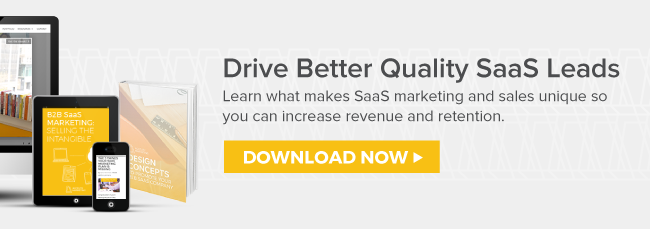4 B2B SaaS Metrics You Should've Started Monitoring Yesterday

Whether your B2B SaaS business is still in its infancy or is already churning a profit, there are several core metrics you should monitor consistently to allow you to make smarter business decisions that boost growth.
If you're looking to boost growth and ensure business success, here are four B2B SaaS marketing and sales metrics your business should've started monitoring yesterday.
1. Customer Acquisition Costs
Arguably the most important metric new SaaS companies should monitor, customer acquisition cost (CAC) is simply the price that comes with acquiring a new customer. A startup needs users if they hope to survive that initial uphill climb.
Since customers actually cost money, the question becomes how much?
Traditionally the marketing department is tasked with following this metric, as it is critical for accurate budgeting and knowing which marketing channels to allocate resources towards. The CAC is calculated by dividing marketing and sales costs by the number of customers acquired within a set time period. You also need to take into account overhead and other expenses.
If you discover your CAC is too high, much higher than you anticipated, you need to start optimizing your landing pages, lead nurturing workflows and your sales emails immediately. By lowering your brand's CAC, you lessen the amount of the time it takes to recoup those costs, allowing you to actually pick up more customers and in the end, improve your customer lifetime value.
2. Churn Rate
Also commonly referred to as customer attrition, customer churn rate is simply the measurement of the number of customers who stop paying for your services. Every business loses customers, especially new businesses with an unverified track record, but the key is to uncover a tolerable churn rate that still produces profits, and to consistently aim for a lower churn level.
While many established companies might measure shorter time periods, like 30 or 45 days, it's advised for new B2B SaaS companies to measure longer periods. Starting with 60 or 90 days is a good rule of thumb. New businesses do this to avoid taking into account customers who are only inactive, or users who are likely going to use the product again in the future and simply missed a payment.
Having a high customer churn rate can stunt your brand's growth, while having a very low or even negative churn rate can be an extremely powerful growth catalyst. Combine churn rate with net monthly recurring revenue churn and you gain insight into the actual dollar value of those churned customers you lost.
3. Monthly Recurring Revenue (MRR)

If you want your new SaaS business to grow, you need to find ways to increase your monthly recurring revenue (MRR), which can happen naturally by increasing sales. Your MRR is calculated by adding total recurring revenue from customers. You should not include one time payments when calculating your MRR.
How often you measure your MRR should align with the measurement of other metrics, such as churn rate, for example. Most startups will calculate recurring revenue from customers at the beginning and end of each month, while some may measure larger time frames, such as every two or three months.
The best way to get your new SaaS business started in a positive direction is to place emphasis on increasing MRR. Because MRR does not take into account other damaging metrics like churn, its usefulness may seem limited, but it does give business owners direct insight into the current health of their company.
4. Customer Lifetime Value
A customer's lifetime value (CLV) is the average amount of revenue you anticipate to generate from each customer for the amount of time they are your clients. In order to calculate this metric you need to know the average length of time your customers will stay with you, which could be two months, nine months, a year or longer. Next you take the revenue you generate from a customer each month and multiply it by that same time period.
If you want your business to thrive, you need to do everything you can to increase your CLV while lowering your CAC. Even if your business is a startup, don't make the mistake of getting overly optimistic about having a CAC that is slightly higher than the CLV, it can actually kill your business.
Utilizing metrics that are right for your B2B SaaS company is a stepping stone to smarter capital allocation and efficient growth.
What B2B SaaS metrics are you measuring to track business success? Let me know in the comments below. Not sure you're monitoring the right metrics correctly? Need guidance? Feel free to contact our Milwaukee marketing agency, Accelity Marketing for more information.


